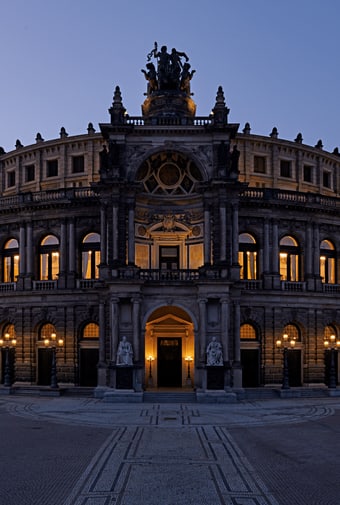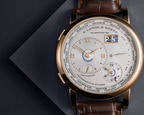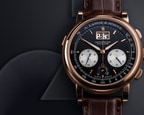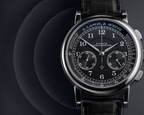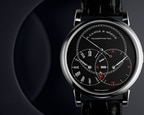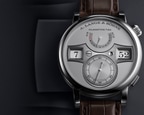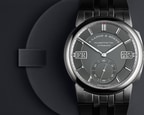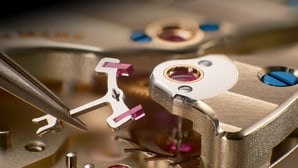An order of consequence
A “respectable chronometer” unlike any the world had ever seen, that was the briefing to master watchmaker Johann Christian Friedrich Gutkaes when he was asked to build a clock for the new opera house in Dresden back in the late 1830s. The watchmaker, who maintained the objects of the Royal Cabinet of Mathematical and Physical Instruments in Dresden’s Zwinger palace, probably conceived this clock in his atelier around the corner of the royal castle, where he had also trained his later son-in-law Ferdinand Adolph Lange as a watchmaker from 1830 to 1835. On 12 April 1841, the Dresden Semper Opera House, called Royal Court Theatre at the time and built by architect Gottfried Semper, was inaugurated. The prominent stage clock caused a furore, being considered a masterpiece of Saxon watchmaking artistry.
New design approaches
The outstanding design may have been inspired by 17th-century French clocks that indicated the time with two framed numeral discs or wheels. It is also possible that the digital-display stage clock of the Scala in Milan has been the role model. For his Five-Minute Clock, Johann Christian Friedrich Gutkaes took an innovative approach with two fabric-lined drums with printed numerals, driven by a wheel train behind a frame with two windows. The clock indicated the hours with Roman numerals I to XII and the minutes with Arabic numerals from 5 to 55 with a blank minute aperture at the top of the hour. When we designed the outsize date after the refoundation in 1990, we adopted this concept for the display, the left-hand aperture also remained blank from the first to the ninth day of the month.
Gutkaes designed and built the clock together with his employees, including his partner and later son-in-law, Ferdinand Adolph Lange. The reason why they implemented the clock with numeral drums is not known, but the most plausible explanation is that the display had to be legible all the way to the rear rows of seats. The drums that had a diameter of about 160 centimetres could accommodate numerals that were roughly 40 centimetres high. The space in the proscenium above the stage was not sufficient for a similarly easy-to-read analogue display.
After the catastrophe
In 1869, a conflagration destroyed the first Dresden opera house and its famous stage clock. Ludwig Teubner, a student of Gutkaes, received a mandate to craft a new stage clock within the scope of the reconstruction project. The result was a large clock that combined elements of traditional tower clocks with design principles of classic watchmaking. It was engineered to the latest standards of the era by Teubner’s workshop and the Zachariä tower clock factory that still exists today. Ludwig Teubner, his son-in-law Ernst Schmidt, and his grandson Felix Schmidt looked after the second clock across three generations.
The functional principle of the second Five-Minute Clock is preserved in a model with a scale of 1:10, which was rebuilt by Teubner’s journeymen Hugo Leipold and Otto Herrmann in 1896. After Teubner’s death, it was passed on to Herrmann, who later emigrated and took it along to Hawaii. From there, in 1951, it was returned to Teubner’s grandson Felix Schmidt. In 1980, he gifted it to the Royal Cabinet of Mathematical and Physical Instruments in Dresden, where it is still exhibited today.
Precursor of a new era
The reconstruction of the Semper Opera House, that had been destroyed in World War II, also involved making a new Five-Minute Clock. This third stage clock was created by a team of experts headed up by engineers Klaus Ferner and Harry Julitz. The reconstruction of the giant clock project involved a cautious modernisation of the drive technology and took over six years to complete.
Since the festive inauguration of the elaborately restored Semper Opera House on 13 February 1985, the silently switching Five-Minute Clock high above the stage delights visitors from all over the world again.
Symbol of Lange watchmaking artistry
Only a few years later, in the early 1990s, special homage was paid to the Five-Minute Clock when its prominent time display inspired the outsize date of our model LANGE 1. Walter Lange, the great-grandson of Ferdinand Adolph Lange, presented it at the Dresden Residential Palace on 24 October 1994. Just as was the case with its large role model, better legibility was the argument for the innovation. Paired with the outsize date, the asymmetrically arranged displays created the level of suspense that transformed the LANGE 1 into our most prominent timepiece.

The LANGE 1 family
The Legend Among Lange Timepieces
Explore further



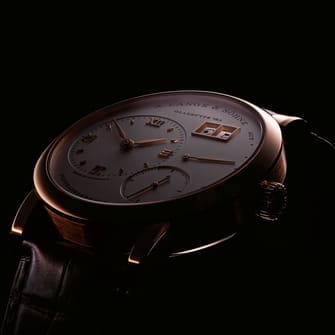
Exclusive insights into the world of fine watchmaking
Experience A. Lange & Söhne’s fascinating heritage, unique stories and exquisite timepieces by subscribing to our newsletter.
How can we be of service?
Whether you are in search of a specific model, have questions out of interest or need a service request for your timepiece – we are delighted to help you. We are at your service by phone, email or in one of our boutiques.

